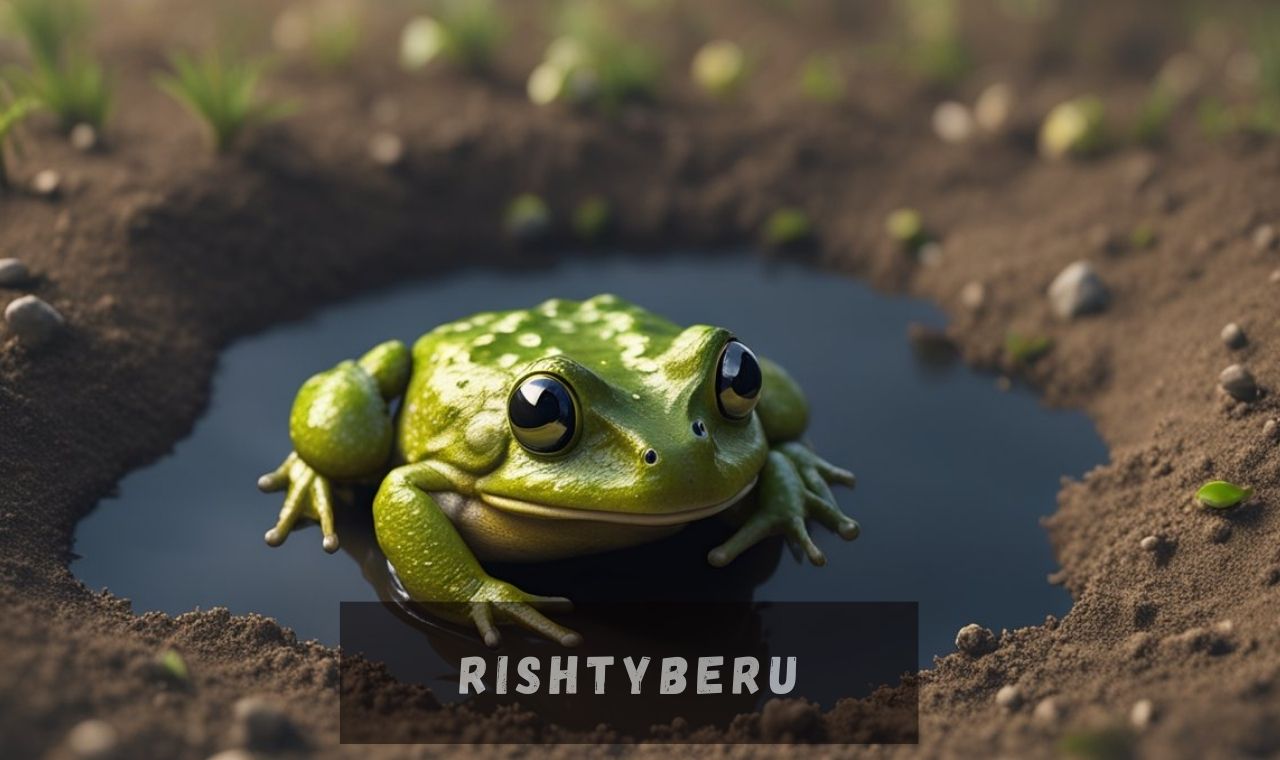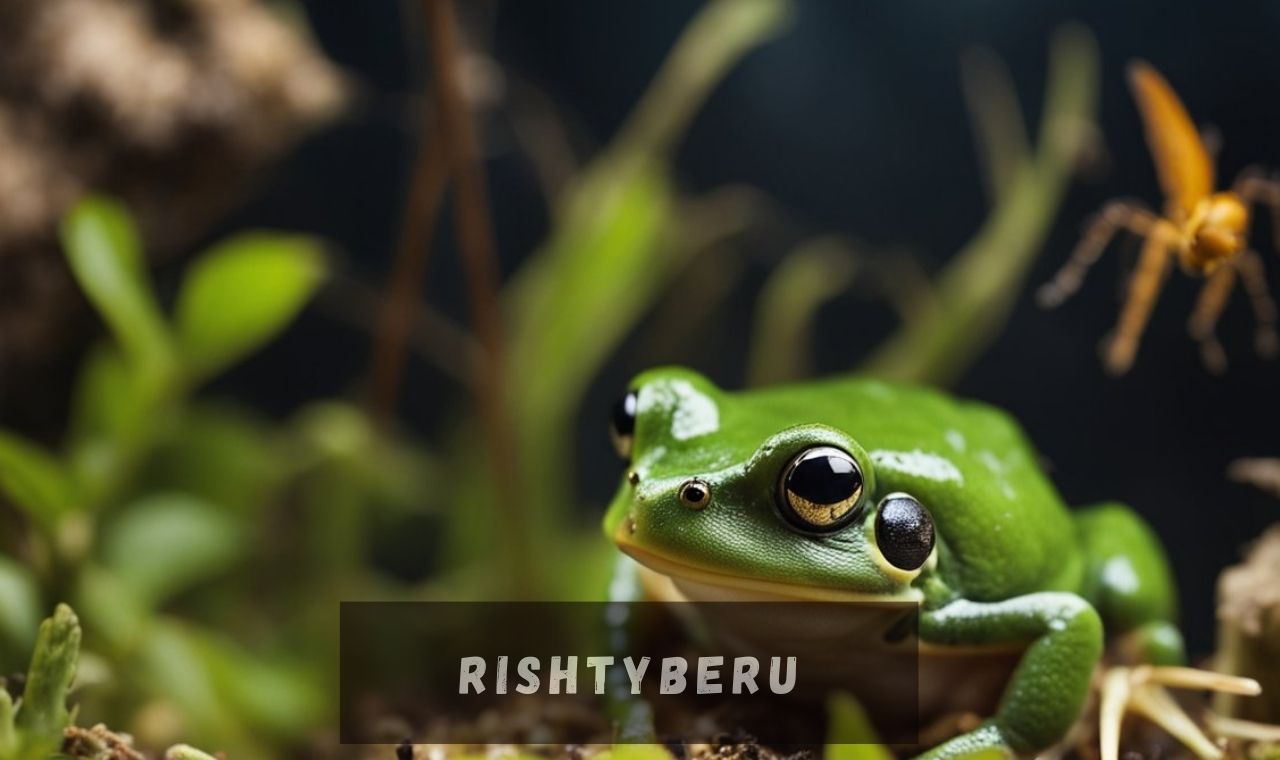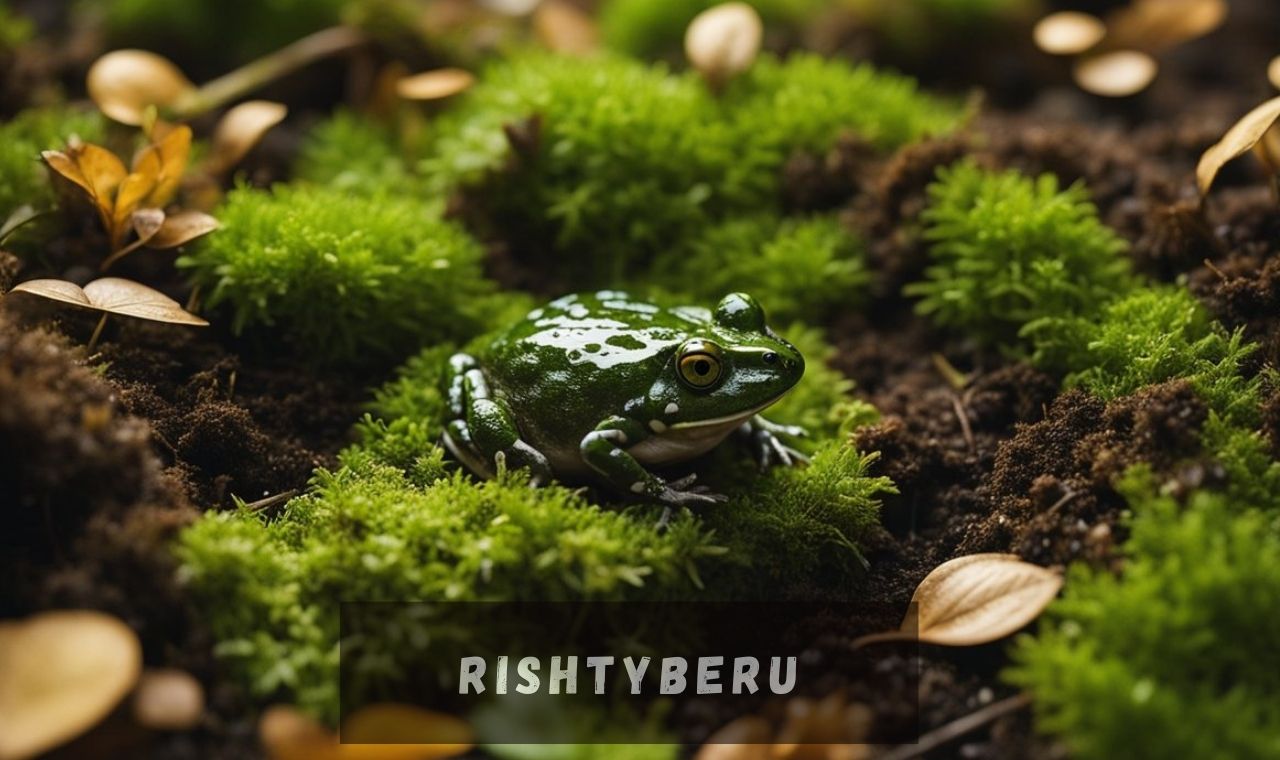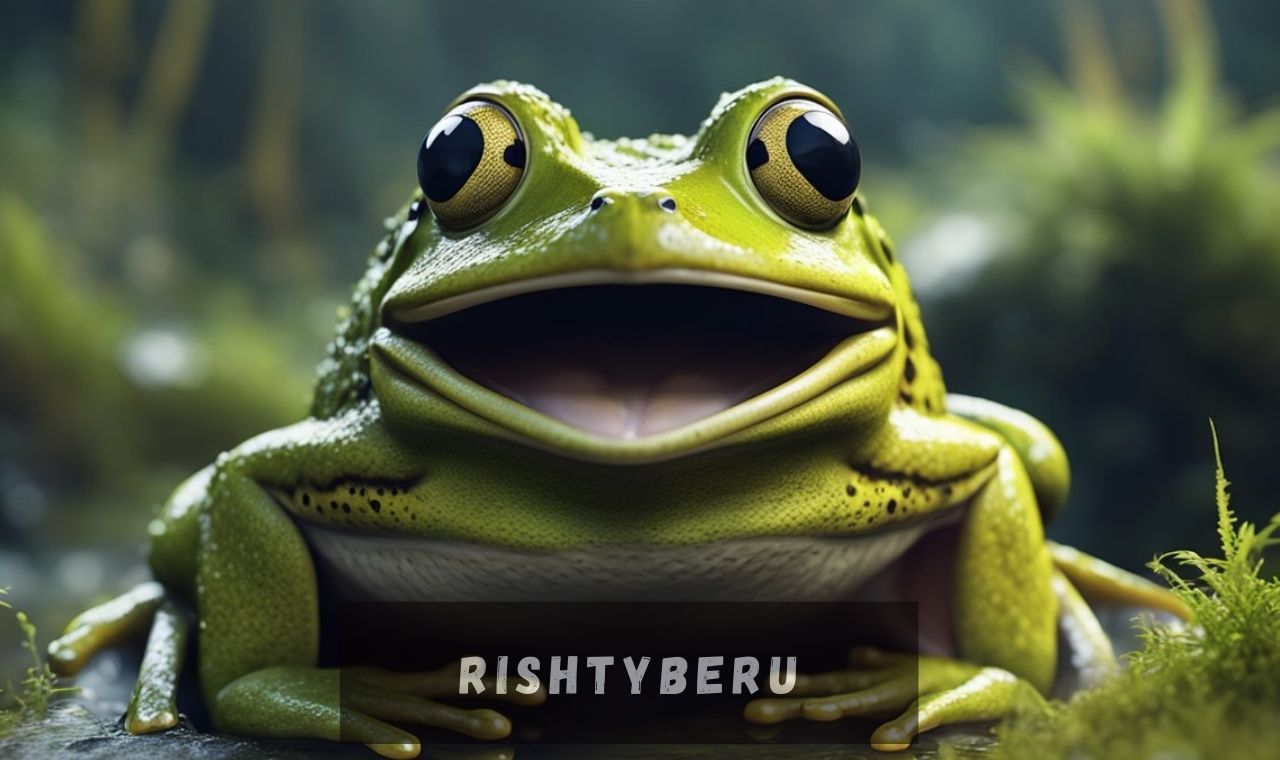Delve into the astonishing fact: Pacman frogs, also known as South American horned frogs, dedicate approximately 70% of their existence beneath the earth’s surface! This remarkable revelation underscores the critical significance of comprehending Pacman Frog Burrowing Habits for both pet enthusiasts and scientific investigators alike. With burrowing deeply ingrained in their genetic makeup, this behavior fulfills multifaceted roles, spanning from defense mechanisms to the regulation of body temperature. Prepare to embark on a captivating expedition as we unravel the enigma behind Pacman Frog Burrowing Behavior, aiming to furnish a thorough understanding of this mesmerizing amphibian trait.
The Innate Urge: Origins of Pacman Frog Burrowing
The distinctive inclination of Pacman frogs towards burrowing finds its origins deeply rooted in their natural habitat and evolutionary adaptations. As we probe into the genesis of this behavior, our focus converges on two intertwined perspectives: their evolutionary journey towards survival and the imperative of simulating wilderness conditions in captive environments.
Survival Through Evolutionary Adaptations
Pacman frogs, native to the lush tropical and subtropical rainforests of South America, exhibit behaviors shaped by their environment, with burrowing being a prominent feature. Nature has honed myriad animal behaviors over evolutionary epochs to enhance survival probabilities.
For Pacman frogs, burrowing serves as a strategic survival tactic facilitating efficient thermoregulation and ensuring adequate hydration. During arid spells, they retreat into their burrows, minimizing water loss and maintaining optimal body temperature. This behavior also acts as a defensive shield, concealing them from predators and augmenting opportunities for ambushing prey.
Replicating Wilderness Conditions in Captivity
In captivity, replicating a Pacman Frog’s natural habitat is paramount to encourage their intrinsic burrowing tendencies. Providing a suitable burrowing substrate— one that retains moisture without compacting excessively— is pivotal in fostering such behavior. By doing so, we promote the health and well-being of these extraordinary creatures.
Recreating wilderness conditions in captivity transcends mere aesthetics; it plays a pivotal role in preserving their physical health and reducing stress by aligning with their natural rhythms and behaviors. Cultivating an environment conducive to burrowing encourages them to manifest their innate instincts, thus enhancing their overall welfare within captive settings.
| Consideration for Captivity | Details |
|---|---|
| Substrate | A substrate that retains moisture but doesn’t compact too tightly, such as coco coir or sphagnum moss, is ideal. |
| Humidity | Ensure that humidity levels are maintained as these frogs come from tropical and subtropical environments. Ideal humidity levels range from 70% to 80%. |
| Temperature | During the day, the habitat should be insulated to keep temperatures between 75 to 85 degrees Fahrenheit, which can be decreased slightly at night. |
Have you ever pondered why Pacman frogs, those captivating amphibians, possess such an affinity for burrowing? It’s not just a quirk; it’s a fundamental survival strategy deeply rooted in their natural instincts. Let’s delve into the three primary reasons driving this behavior: thermoregulation, moisture maintenance, and security.
Mastering Body Temperature: The Art of Thermoregulation
Much like us, Pacman frogs are sensitive to temperature fluctuations. Being ectothermic creatures, they rely on their environment to regulate their body heat. Burrowing becomes their refuge, shielding them from the harsh elements of scorching days or chilly nights. By retreating into the substrate, they maintain a comfortable body temperature, ensuring their well-being.
A Damp Haven: Retaining Essential Moisture
In their native humid habitats, Pacman frogs thrive on moisture to keep their delicate skin hydrated. Burrowing deep within the substrate creates a microclimate of humidity, safeguarding them against dehydration. This becomes especially crucial in captive settings, where artificial heat sources pose a threat to their moisture levels.
Vanishing Act: Evading Predators with Stealth
The wild is fraught with dangers for these diminutive creatures, from slithering snakes to swooping birds. Burrowing provides them with a cloak of invisibility, a means to evade prying eyes and potential threats. Even in captivity, this instinctual behavior persists, offering them a sense of security against imagined dangers.
In essence, understanding the intricate relationship between Pacman frogs and their burrowing behavior is key to providing them with optimal care and ensuring their flourishing in captivity. By honoring their natural instincts, we pave the way for their health and well-being, echoing the harmony of their wild habitats.
| Reasons Why Pacman Frogs Burrow | Description |
|---|---|
| Thermoregulation | Helps in maintaining the ideal body temperature to survive extreme conditions. |
| Moisture Retention | Facilitates a humidity-controlled environment to prevent their skin from drying out. |
| Escape from Predators and Security | Assists in blending into their surroundings, thus hiding from potential threats and instilling a sense of security. |
Understanding why Pacman frogs burrow is pivotal for ensuring their flourishing, whether in captivity or the wild. Replicating their natural habitat authentically, considering factors like temperature gradients, suitable substrates, and providing a sense of security, fosters their innate burrowing behavior, thus enhancing their well-being.
Deciphering Pacman Frog Burrowing Behavior
Delving into the burrowing tendencies of Pacman frogs is essential for their thriving in captive environments. It transcends mere acknowledgment of the importance of burrows for these captivating amphibians, offering profound insights into their natural behaviors and facilitating the creation of ideal conditions for their health and welfare.
Pacman frogs exhibit industrious digging, primarily burrowing deeper into substrates as their main burrow preparation method. Their burrowing behavior is greatly influenced by environmental parameters such as temperature, humidity, and substrate quality.
The onset of burrowing often coincides with observable behavioral changes, including reduced activity, alterations in appetite, and a noticeable interest in specific areas of the terrarium. By attentively observing these behaviors, pet owners can anticipate when a Pacman frog is likely to begin burrowing.
Selecting a burrowing spot is a deliberate process for these frogs, influenced by factors like proximity to water and food sources, substrate consistency, and the level of security provided by the chosen location.
To deepen our understanding, let’s explore notable behaviors during the burrowing process:
Pushing: Pacman frogs initiate burrowing by pushing their bodies into the substrate.
Kicking: Using their hind legs, these amphibians may kick substrate away from the burrow site to create a more comfortable space.
Spinning: When faced with tougher substrate, Pacman frogs may spin in circles to loosen it before digging deeper.
“These behaviors illuminate the determination and adaptability of Pacman frogs, showcasing their commitment to natural behaviors even in captivity.”
In Crafting a Burrowing Environment for Pacman Frogs, insights gleaned from studying these behaviors prove invaluable. By comprehending their burrowing habits, we can tailor our terrarium setups and care practices to meet the instinctual needs of Pacman frogs.
Pacman Frog’s Natural Habitat: Unveiling Their Wild Realm
Understanding the specifics of a Pacman frog’s natural habitat provides crucial insights for creating a conducive environment for these amphibians in captivity. Originating from subtropical and tropical regions, Pacman frogs rely heavily on climate factors such as temperature and humidity for survival and well-being. By grasping these conditions, we can simulate their natural environments more accurately, potentially enhancing their overall health and reproductive success.
The Significance of Humidity and Temperature for Pacman Frogs
Ensuring proper humidity and temperature levels is paramount for the well-being of Pacman frogs. These amphibians thrive in environments with high humidity, typically around 70-80%. This level of humidity aids in moisture retention, which is crucial for Pacman frogs due to their semi-permeable skin. Additionally, they prefer warm surroundings, with ideal temperatures ranging between 75 and 85 degrees Fahrenheit. Although they can tolerate slightly cooler conditions at night, maintaining these climatic conditions is essential for their overall health.
Habitats: From Forest Floors to Domestic Dwellings
Pacman frogs are commonly found on forest floors, where they blend seamlessly into leaf litter and soft, loamy soil. Their natural habitats are characterized by lush vegetation, ample rainfall, and warm temperatures, providing them with an optimal environment. Replicating these conditions in captivity involves creating a suitable habitat with the right substrate, humidity levels, and temperature. Understanding the Pacman frog’s natural habitat can significantly enhance their well-being in captivity, ensuring longevity and facilitating reproduction.
Reasons for Burrowing in Pacman Frogs: Promoting Health and Well-being
Exploring the motivations behind Pacman frogs’ burrowing behavior reveals its importance beyond mere instinct. Burrowing plays a crucial role in maintaining the health and well-being of these intriguing amphibians. It directly impacts their longevity, survival, and overall quality of life, whether in the wild or captivity.
One of the most significant health benefits of burrowing is stress reduction. Pacman frogs are solitary creatures, and factors such as confinement, unfamiliar noises, or sudden movements can elevate their stress levels. Burrowing serves as an effective coping mechanism, providing them with a secure and comforting retreat, thereby lowering their stress levels and promoting overall well-being.
| Health Benefit | Description |
|---|---|
| Reduced stress | In the security of their burrow, pacman frogs can relax and reduce stress levels, thereby promoting overall well-being. |
| Lower risk of dehydration | By burrowing, pacman frogs can retain vital moisture, lowering the risk of dehydration, a common issue faced by amphibians in captivity. |
| Protection from infections | Proper burrowing, aided by the correct substrate, helps maintain optimal humidity levels, decreasing the risk of skin infections prevalent in low-humidity environments. |
Creating an optimal environment for burrowing Pacman frogs is essential for their well-being and vitality. By understanding and accommodating their natural behaviors, you can ensure they thrive in captivity. Here are some exclusive care tips tailored to cater to the burrowing needs of your Pacman frog:
Unveiling the Perfect Terrarium Setup
Crafting a suitable terrarium setup goes beyond just providing substrate. Integrate hiding spots such as hollow bark and reserve a dry area within the enclosure for the frog to emerge from its burrow and relax. Moreover, maintain a shallow substrate depth along the edges to facilitate burrowing without risking substrate collapse.
Selecting the Ideal Substrate
The substrate choice significantly impacts Pacman frog burrowing behavior. Opt for gentle substrates like organic potting soil, coconut fiber, or sphagnum moss, steering clear of sharp materials like gravel that could harm the frog during burrowing endeavors.
Monitoring Humidity and Temperature Levels
Maintaining proper humidity and temperature is crucial for the health and comfort of burrowing Pacman frogs. Sustain humidity levels between 50 to 70% through regular misting, while ensuring temperatures range between 75-85°F (24-29°C) with the help of thermostatically controlled heaters. Consistent environmental conditions are vital for effective thermoregulation during burrowing activities.
By implementing these tailored care strategies, you can create a nurturing environment that supports the natural instincts and well-being of your burrowing Pacman frog.
Exploring Ground Options for Pacman Frog Dens Crafting an ideal habitat for your Pacman frog extends beyond mere terrarium aesthetics. A pivotal aspect involves selecting the right ground cover that mirrors the frog’s native environment and encourages its instinctual burrowing tendencies. Here, we delve into a variety of commercially available ground options, delineating their merits and demerits to assist you in fashioning an optimal burrowing haven for your Pacman frog.
Diverse Ground Options for Pacman Frog Dens span from organic substrates to synthetic overlays. Each ground choice boasts unique advantages and potential drawbacks, with the optimal selection contingent upon the specific needs of the individual frog, its habitat conditions, and the owner’s upkeep capacity.
Coconut Fiber: Extracted from coconut husks, this ground material is chemically inert, enduring, and organic. It fosters a moist milieu, ideal for excavation and burrowing. However, desiccation may lead to dust emission, posing respiratory risks to frogs.
Sphagnum Moss: This natural ground covering adeptly retains moisture, replicating the humid habitat Pacman frogs thrive in. Nevertheless, periodic replacement might be necessary due to bacterial and mold proliferation.
Additionally, there exist other viable options, notwithstanding their commercial origin, which can serve as commendable alternatives for constructing a Burrowing Environment for Pacman Frogs.
Reptile Bark: This substrate excels in moisture retention and lends a rustic aesthetic to the enclosure. Nonetheless, ingestion of large bark pieces during feeding could pose a choking hazard.
Artificial Ground Covers: Examples encompass reptile carpeting and excavator clay. While these are easily cleaned and maintained, they lack the organic texture and burrowing opportunities inherent in natural materials.
Bear in mind, the paramount consideration in selecting the substrate for your Pacman frog is ensuring it’s safe, conducive to burrowing, and manageable for upkeep. Your choice should be guided by the frog’s unique requirements and behaviors, furnishing them with a domicile that faithfully echoes their natural habitat.
In the ensuing table, we juxtapose the four ground options based on criteria such as their natural appeal, suitability for burrowing, and ease of maintenance.
| Substrate | Naturalness | Suitability for Burrowing | Ease of Maintenance |
|---|---|---|---|
| Coconut Fiber | High | High | Medium |
| Sphagnum Moss | High | Medium | High |
| Reptile Bark | Medium | Medium | High |
| Artificial Substrates | Low | Low | High |
Ensuring your Pacman frog thrives begins with selecting the perfect substrate. Take your time in choosing, balancing your frog’s preferences with your ability to maintain cleanliness.
Creating a Burrow Haven for Pacman Frogs
In the realm of Pacman frog care, establishing an optimal burrowing environment is paramount. This endeavor not only nurtures their natural instincts but also safeguards their health and happiness.
Key Components for a Pacman Frog’s Habitat
The crux of a Pacman frog’s burrowing environment lies in mimicking its natural habitat as closely as possible. A well-appointed terrarium should encompass:
- Substrate: Opt for suitable options like coconut fiber, sphagnum moss, or organic soil to facilitate comfortable burrowing.
- Humidity and Temperature: Ensure these are meticulously regulated to mirror their natural surroundings.
- Water Source: A shallow dish aids hydration and shedding.
- Decor: Incorporate live plants, logs, and stones for additional hiding and burrowing spots.
These elements are vital for your frog’s contentment and to encourage its natural behaviors.
DIY Strategies for a Burrow-Friendly Setup
Crafting a burrow-friendly terrarium doesn’t necessitate intricate skills or equipment. Consider these DIY tips:
- Maintain loose, deep substrate, at least double the frog’s length for ample burrowing space.
- Regularly mist the terrarium to sustain appropriate humidity levels, especially in burrowing areas.
- Monitor temperature diligently with a reliable thermometer to ensure it remains ideal for Pacman frogs.
- Position the water dish within easy reach but away from preferred burrowing spots.
Following these guidelines fosters an environment conducive to your Pacman frog’s burrowing instincts, contributing to its overall well-being and happiness.
Spotting Common Issues in Pacman Frog Burrowing Behaviors

In the enchanting realm of Pacman frogs, burrowing isn’t just a mundane activity; it’s a captivating glimpse into their mysterious world. However, just like humans, these fascinating creatures can sometimes use their subterranean escapades to communicate distress or discomfort. Let’s delve deeper into deciphering the signals behind their underground antics to ensure the well-being of our amphibian pals.
Unearthing Signs of Stress
In the ordinary course of Pacman frog life, burrowing serves as a vital tool for maintaining body temperature, preserving moisture, and evading potential threats. Yet, deviations from this norm – whether excessive digging or an uncharacteristic aversion to burrowing – often hint at underlying stressors. Disregarding these subtle cues may exacerbate the frog’s woes, so it’s crucial to pay heed.
While it’s customary for Pacman frogs to retreat underground for extended periods, persistent seclusion or a reluctance to emerge, even during meal times, should ring alarm bells. Likewise, a flurry of frenzied digging or an abrupt disinterest in burrowing activities warrants closer inspection.
Embarking on a Journey: Common Stress Signals Encountered During Burrowing
Here’s a curated list of telltale signs to aid in your quest for understanding and addressing stress in Pacman frogs:
| Sign | Interpretation |
|---|---|
| Reluctance to emerge from burrow | Potential indication of distress or discomfort |
| Consistent hiding during feeding times | Signals heightened stress levels amidst routine activities |
| Excessive digging | Suggests agitation or unease in the frog’s environment |
| Abrupt loss of interest in burrowing | May signify underlying health issues or environmental stress |
By attuning ourselves to these subtle manifestations, we can embark on a journey of empathy and support for our Pacman frog companions, ensuring their well-being and happiness in their underground abodes.
Maintaining Your Pacman Frog’s Burrow Health
Keeping an eye on your Pacman frog’s burrowing habits is crucial for spotting any potential issues early on. Ensuring the terrarium maintains the right humidity and temperature levels, along with using suitable substrate, is essential for their well-being.
If you notice unusual burrowing patterns persisting, it’s best to seek advice from a qualified herpetologist or veterinarian. These professionals can identify and address health issues such as dehydration, skin infections, or metabolic problems. They can also suggest adjustments to your husbandry practices to restore your Pacman frog’s natural burrowing behavior.
Guide: Preventative Measures and Treatments for Burrow-Related Concerns
| Issues | Preventive Measures | Possible Treatments |
|---|---|---|
| Dehydration | Maintaining proper humidity level in the terrarium | Rehydration under expert supervision |
| Skin Infections | Regular cleaning of terrarium and frequent substrate change | Topical or oral medications prescribed by a vet |
| Anxiety or Stress | Adequate burrowing space and hideouts, reducing handling | Behavioral therapy, change in husbandry practices |
Acknowledging the Essence of Normal Burrowing Patterns
By heeding the significance of typical burrowing behaviors and staying vigilant for any deviations, you can guarantee a wholesome and stress-free environment for your beloved Pacman frog.
In Conclusion
As we draw the curtains on our exploration of Pacman frog burrowing tendencies, it becomes evident how crucial it is to comprehend and accommodate these innate instincts. Recognizing the myriad reasons behind burrowing, from regulating temperature and moisture to evading predators, enables us to offer top-tier care for these distinctive amphibians.
Summarizing the Significance of Understanding Burrowing
The initial stride toward impeccable care is grasping the evolutionary significance and indispensability of burrowing in Pacman frogs. This piece dissected the primary motives behind the behavior, furnishing a backdrop for why establishing a conducive burrowing milieu is imperative in captive habitats. Ultimately, comprehending Pacman frog burrowing behaviors is pivotal to safeguarding their overall health and well-being.
Conducive to the Holistic Well-being of Your Pacman Frog
Ultimately, the vitality and contentment of your Pacman frog hinge greatly on how closely their captive habitat mirrors their natural surroundings. As conscientious pet custodians, it behooves us to furnish their terrariums with optimal burrowing conditions, encompassing suitable substrate selections, meticulous humidity, and temperature regulation. These elements wield substantial influence over your Pacman frog’s health and overall quality of life.
Our grasp and ensuing actions can significantly bolster the holistic well-being of your Pacman frog. Hence, by staying attuned to their requisites and crafting an environment that aligns with their instincts, we safeguard their welfare. Remember, a joyful Pacman frog is one that actively engages in burrowing!



